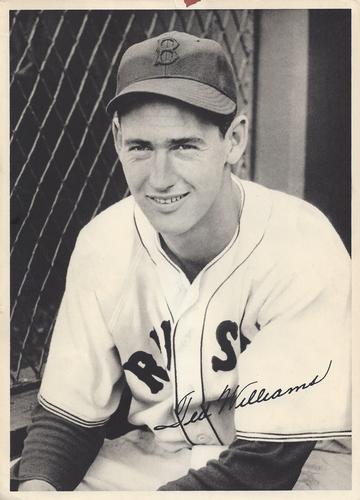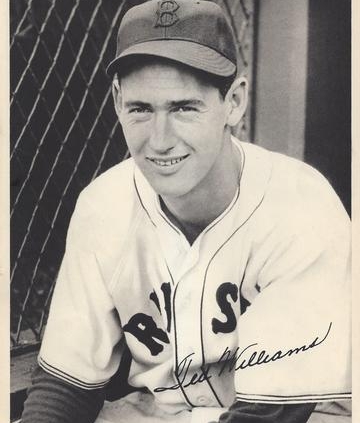September 30, 1939: Red Sox rookie Ted Williams completes quest to homer in every ballpark
 The September 30 doubleheader between the New York Yankees and visiting Boston Red Sox turned out to be the last two games of the 1939 regular season for both teams. Another doubleheader was scheduled for the next day, but it was rained out.
The September 30 doubleheader between the New York Yankees and visiting Boston Red Sox turned out to be the last two games of the 1939 regular season for both teams. Another doubleheader was scheduled for the next day, but it was rained out.
It’s a good thing for Red Sox right fielder Ted Williams that he homered in this day’s second game rather than wait another day. His fourth-inning home run at Yankee Stadium, his 31st of the season, gave the young rookie at least one homer in every American League ballpark, including both ballparks used by the Cleveland Indians in 1939.1
The Red Sox were in second place, and the Yankees in first place, but the games were anticlimactic to say the least – the Yankees had a 17-game lead over Boston.
New York won the first game, 5-4, increasing its lead by another game. Williams doubled to center field in the first inning, but that was his only hit of the game and he struck out twice.
Right-hander Steve Sundra started the second game for the Yankees. He was 11-0 for the season, and 17-4 lifetime.
First baseman Lou Finney singled with one out in the top of the first, and Williams walked, but shortstop-manager Joe Cronin popped up to second base, and second baseman Bobby Doerr grounded out.
Pitching for the visiting Red Sox was Jack Wilson, a right-hander concluding his fifth season with the team. He was 10-11. He, too, allowed a single (by shortstop Frankie Crosetti) and a walk (to right fielder Tommy Henrich). No runs scored.
Sundra set down the Red Sox in order in both the second and the third. Cronin’s error allowed catcher Buddy Rosar to reach base in the bottom of the second inning and another Cronin error allowed Bill Knickerbocker, who’d come into the game to replace Crosetti after the first inning, to reach first base in the third.2 Henrich added a single, but by that time Knickerbocker had already been removed when third baseman Red Rolfe hit a ball to Williams in right field, and Williams threw to first base to double him up. No runs scored for the Yankees, either.
The game was still scoreless when Williams led off the top of the fourth against Sundra. Williams snapped the tie by homering “into the chummy right-field seats” at Yankee Stadium.3 At 21 years old, he had completed the cycle of hitting a home run in every AL park in 1939 – a goal that he apparently was known to have wanted to achieve. John Drohan of the Boston Herald wrote, “When Ted Williams drilled his 31st home run of the season into that sector of Yankee Stadium once known as Ruthville here today he realized an ambition cherished since the opening of the season.”4
Boston added one more run in the fifth. Third baseman Jim Tabor reached on an error by his counterpart, Rolfe. Gene Desautels, the catcher, successfully sacrificed him to second base. Wilson grounded back to Sundra, and Tabor was unable to advance. Red Nonnenkamp, playing center field for Boston, drew a base on balls. Finney singled to center field, scoring Tabor. It was 2-0, Red Sox. Williams walked, but Cronin grounded out to Rolfe, with the throw to second forcing Williams.
Sundra singled off Wilson in the bottom of the fifth, but Knickerbocker hit into a 6-4-3 double play and Rolfe flied out.
Doerr doubled to start the sixth. Left fielder Joe Vosmik bunted to third base and reached first safely on a single. Tabor hit a high popup caught by catcher Rosar. Desautels also laid down a bunt for a single, and Doerr scored the third Red Sox run. After Wilson flied out to left, Nonnenkamp hit one to left, too, one which went for a single, allowing Vosmik to score for a 4-0 lead. Finney grounded out.
Three fly balls off Wilson – to catcher, second base, and left field – and the Yankees were out in the bottom of the sixth.
Williams struck out leading off Boston’s seventh inning. Both Cronin and Doerr singled, but nothing was added in the way of runs.
The Yankees scored twice in the bottom of the seventh. The first two batters hit outfield flies, but Babe Dahlgren singled and then Charlie Keller pinch-hit for Sundra. Keller homered into the lower left-field stands to break up Wilson’s shutout. Knickerbocker flied out to Vosmik in left field.
The game was stopped after seven innings due to darkness. It had taken only 75 minutes to play, before an audience of just 7,501. Perhaps Yankees fans were saving their money for the coming World Series. New York swept the Cincinnati Reds in four games
Sundra’s streak had been stopped. He finished the season 11-1. Wilson evened his season record at 11-11.
It was an “all-day drizzle” that forced postponement of the next day’s planned doubleheader, scheduled for the final day of the regular season. Williams, Cronin, and a couple of Red Sox coaches decided to stay in New York to see the first game of the World Series.5
Though the Yankees had finished so far ahead of the Red Sox, Boston held the edge in head-to-head competition. The Red Sox won 11 games to New York’s 8, making them the only team to have a winning record against the 1939 Yankees. Boston was also the first team to post a winning record in a season series against the Yankees since the 1934 Tigers.6
Williams’s solo home run gave him 145 runs batted in for the season. It was the first time a rookie had ever led the league in RBIs. It remains as of 2021 the major-league rookie record for runs batted in during a season, even with the expanded 162-game schedule.
In 521: The Story of Ted Williams’ Home Runs, the author wrote: “In his rookie year, only eight of Ted’s 31 homers were solo shots. He hit 12 two-run homers, nine three-run homers, and two grand slams.
“He hit four in Detroit and four in St. Louis.
“In years to come, once or twice there was a rumor that Williams would be traded to the Yankees – maybe even a trade for Joe DiMaggio – and that Ted would wreak havoc there because of the Stadium’s close right-field porch. Ted wrote: ‘ I didn’t like Yankee Stadium. A bad background in center field when the crowd is big, and all that smoke hanging in there. … I always felt jacked up in Yankee Stadium because of the crowds, but I never wanted to play there.’ 7
“Fourteen of Ted’s 31 home runs were hit at Fenway Park. No other left-handed hitter on the team hit more than one.
“Nine of his homers were game-winners, tying him with 1947 and 1956 for game-winners in a single season.”8
Sources
In addition to the sources cited in the Notes, the author consulted Baseball-Reference.com and Retrosheet.org.
https://www.baseball-reference.com/boxes/NYA/NYA193909302.shtml
https://www.retrosheet.org/boxesetc/1939/B09302NYA1939.htm
Notes
1 “The Indians had two home fields in the late 1930s – the smaller League Park and (for larger games, such as weekend affairs) the larger-capacity Cleveland Stadium. Ted had homered at Cleveland Stadium back on July 15, so he’d now homered in each of the two Indians ballparks.” Bill Nowlin, 521: The Story of Ted Williams’ Home Runs (Cambridge, Massachusetts: Rounder Books, 2013), 22.
2 Crosetti had fouled a ball off his own right ear while batting in the first inning, “cutting the lobe of the ear.” James P. Dawson, “Sundra Is Halted as Yankees Divide,” New York Times, October 1, 1939: 89. Crosetti was able to play in all four games of the World Series, though he was 1-for-16 at the plate. He did drive in the first run of the game in New York’s Game Two win, on a productive ground ball out.
3 Gerry Moore, “Sox Snap Sundra’s String by Winning Nightcap, 4 to 2,” Boston Globe, October 1, 1939: B28.
4 John Drohan, “Ted Williams’ 31st Homer Starts Sox Toward 4-2 Win,” Boston Herald, October 1, 1939: 70.
5 Gerry Moore, “Sox, Rained Out, Start for Homes,” Boston Globe, October 2, 1939: 6.
6 Thanks to Andrew Harner for this information.
7 Ted Williams, with John Underwood, My Turn at Bat (New York: Simon & Schuster, 1969), 114.
8 Nowlin, 31.
Additional Stats
Boston Red Sox 4
New York Yankees 2
Game 2, DH
Yankee Stadium
New York, NY
Box Score + PBP:
Corrections? Additions?
If you can help us improve this game story, contact us.


